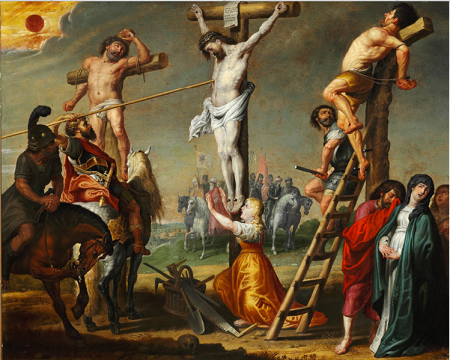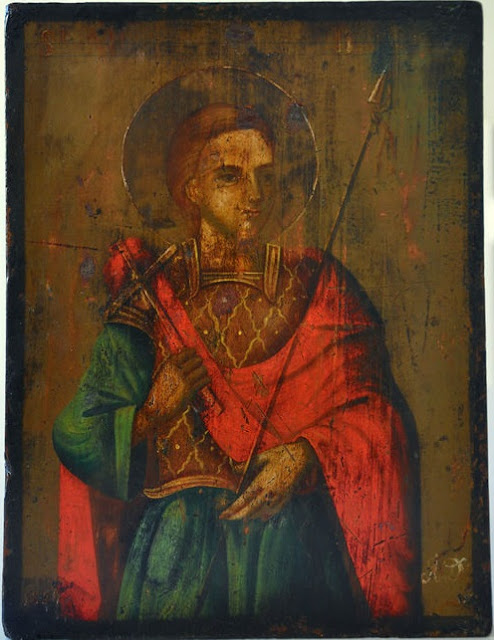Fyodor Evtikhievich Zubov
Longinus the Centurion, c. 1680
Russian icon
Grand Kremlin Palace
Fyodor Evtikhievich Zubov (1615 – November 3, 1689), was a Russian painter, engraver, miniaturist and illuminator.
Zubov was born in Solikamsk, a member of the noble Zubov family. He began working in Veliky Ustyug and Yaroslavl. In 1662 he moved to Moscow where he worked with Simon Ushakov. His work included icons, illuminated manuscripts, drawings for engravings, and wall paintings. When Ushakov died in 1686, Zubov took over as the Director of the Imperial Workshop of Icon Painters in the Kremlin Armoury. He died in Moscow, in 1689. More on Fyodor Evtikhievich Zubov
Longinus is the name given in Christian mythology to the unnamed Roman soldier who pierced Jesus in his side with a lance. The lance is called in Christianity the “Holy Lance” during the Crucifixion. This act is said to have created the last of the Five Holy Wounds of Christ.
Gerard de la Vallée, (1596–)
Longinus piercing Christ's side with a spear, c. between 1626 and 1667
Oil on copper
Height: 70 cm (27.5 in); Width: 89 cm (35 in)
Private collection
Gerard de la Vallée (1596/1597 – after 1667) was a Flemish painter of landscapes and history paintings. His work was inspired by the great Flemish masters and mainly produced for the export market.
The artist was born in Mechelen in 1596 or 1597. He was active in Paris from 1620 to 1625. In 1625 he is again recorded in Mechelen where he produced a painting for the Baroque church .
In the guild year 1626-1627 he was documented in Antwerp when he registered as a master in the local Guild of Saint Luke under the name Geeraert de la Vallee. De la Vallee worked for the Forchondt workshop. Many of the works produced in the Forchondt workshop, including those of Gerard de la Vallée, used copper as the support. This made it easier to export them from Antwerp to Seville where Forchondt had a trading post. From Seville the artworks where shipped through Cádiz to Vera Cruz (Mexico) where they were sold to local convents.
Gerard de la Vallée's works are often derived from, or inspired by, the works of the great masters of the Antwerp school. The mining of images of other masters to create new works for the export market was a hallmark of the Forchondt workshop and is also evident in de la Vallée's work.
Saint Longinus lived in the reign of the Emperor Tiberius (AD 15-34). He came from Cappadocia and served as a centurion in the Roman army, under the orders of Pilate, the Governor of Judaea.
Fra Angelico, (circa 1395 –1455)
Crucifixion with lance by Captain Longinus, circa 1437-1446
Fresco
Dominican monastery of San Marco in Florence
Museum of San Marco Blue pencil.svg wikidata:Q13453137
Fra Angelico (born Guido di Pietro; c. 1395 – February 18, 1455) was an Italian painter of the Early Renaissance, described by Vasari in his Lives of the Artists as having "a rare and perfect talent".
He was known to contemporaries as Fra Giovanni da Fiesole and Fra Giovanni Angelico . In modern Italian he is called Beato Angelico; the common English name Fra Angelico means the "Angelic friar".
In 1982, Pope John Paul II proclaimed his beatificatio in recognition of the holiness of his life, thereby making the title of "Blessed" official. Fiesole is sometimes misinterpreted as being part of his formal name, but it was merely the name of the town where he took his vows as a Dominican friar, and was used by contemporaries to separate him from others who were also known as Fra Giovanni.
Vasari wrote of Fra Angelico that "it is impossible to bestow too much praise on this holy father, who was so humble and modest in all that he did and said and whose pictures were painted with such facility and piety." More on Fra Angelico
He and his men were commanded to carry into effect Pilate’s sentence regarding the holy Passion of Jesus Christ, and to guard the tomb for fear the disciples should come and steal away His body to lend credence to His resurrection.
Lavinia Fontana, (1564–1614)
Christ with the Symbols of the Passion, c. 1576
Oil on panel
Height: 40 cm (15.7 in); Width: 30.2 cm (11.8 in)
El Paso Museum of Art
Symbols of Christ's suffering: the Cross, the column of the flagellation, the angel at the right has three nails, the wounds in Christ's body, the whip, and the Crown of Thorns. Christ is out of proportion to the other figures, influenced by Michelangelo's Florentine Pietà.
Lavinia Fontana (August 24, 1552 – August 11, 1614) was a Bolognese Mannerist painter best known for her portraiture. She was trained by her father Prospero Fontana and was active in Bologna and Rome. She is regarded as the first female career artist in Western Europe as she relied on commissions for her income. Her family relied on her career as a painter, and her husband served as her agent and raised their eleven children. She was perhaps the first woman artist to paint female nudes.
Fontana and her family moved to Rome in 1603 at the invitation of Pope Clement VIII. She gained the patronage of the Buoncompagni, of which Pope Gregory XIII was a member. She was subsequently appointed as Portraitist in Ordinary at the Vatican. Lavinia thrived in Rome as she had in Bologna and Pope Paul V himself was among her sitters. She was the recipient of numerous honors.
She was elected into the Accademia di San Luca of Rome. She died in the city on August 11, 1614 and was subsequently buried at Santa Maria sopra Minerva. More on Lavinia Fontana
So it came about that Longinus witnessed all the astonishing miracles that accompanied Christ’s Passion: the earthquake, the darkening of the sun, the rending of the veil of the temple, the splitting of the rocks, the opening of the graves and the appearance, in their risen bodies, of many of the Saints of ancient times. The eyes of the centurion’s heart were opened at the sight of these portents, and he cried with a loud voice: Truly, this man was the Son of God!
Jacques Joseph Tissot, (French, 1836-1902)
The Confession of the Centurion, c. 1886-1894
Opaque watercolor over graphite on gray wove paper
6 7/16 x 10 7/8 in. (16.4 x 27.6 cm)
Brooklyn Museum,
Jacques Joseph Tissot (15 October 1836 – 8 August 1902), Anglicized as James Tissot, was a French painter and illustrator. He was a successful painter of Paris society before moving to London in 1871. He became famous as a genre painter of fashionably dressed women shown in various scenes of everyday life. He also painted scenes and characters from the Bible. More on James Tissot
Jacques Joseph Tissot, (French, 1836-1902) The Resurrection, c. 1886-1894
Opaque watercolor over graphite on gray wove paper
12 13/16 x 8 5/16 in. (32.5 x 21.1 cm)
Brooklyn Museum
Emerging out of a tomb sealed with a large stone and guarded by watchmen, Jesus miraculously rises from the dead. His face shines forth and the wounds on his head, hands, feet, and chest glow bright white. The guards shook and “became as dead men,” Matthew says, at the sight of the risen Jesus, falling backwards in abject terror.
Jacques Joseph Tissot (15 October 1836 – 8 August 1902), see above
On the third day, when the guards witnessed the Angel appearing to the holy women at the tomb, they shook with fear and became as dead men. Some of them went to tell the chief priests of the Jews all that had happened. The chief priests and elders met and decided to give Longinus and his men a large sum of money, if they would put it about that the disciples had come by night and stolen away Christ’s body while the guards were asleep. But Longinus and two of his soldiers refused this money. So, leaving the army and his military duties behind him, Longinus went back to his home country of Cappadocia, where he preached the Good News just as the Apostles were doing. When Pilate learnt of this he wrote to the Emperor Tiberius denouncing Longinus, which the chief priests, bent on vengeance, had prevailed on him to do by giving him money and presents.
The men the Emperor sent in search of Longinus
43.2 x 28.8 cm | 17 x 11.3 inches |
Grosvenor Museum, Grosvenor Street Chester, Cheshire, England, UK
I have no further description, at this time
The men the Emperor sent in search of Longinus called at the house where he had taken refuge; they asked for hospitality and for information as to the whereabouts of the deserter, who was unknown to them by sight. It was the Saint himself who received them, with the care for strangers customary among disciples of Christ. As they talked, Longinus was exceedingly joyful on learning the purpose of their journey, and he redoubled his efforts to put his guests at their ease.
Unknown artist
Martyr Longinus Centurion
Miniature Minology of Vasily II. Constantinople. 985
Vatican Library. Rome
Then he left them, and with complete serenity prepared his grave and everything necessary for his burial. He went to look for the two companions who had fled from Palestine with him, and they decided to offer themselves to martyrdom at his side. He then went back to his guests and told them that he was the Longinus they were looking for to put to death. The Emperor’s agents were astounded at the calmness of his manner and, considering the hospitality they have received, deeply distressed because of the dark deed they had come to do. But the Saint implored them to make haste in uniting him and his companions to their Lord and Master. Sick at heart, they beheaded the three disciples of Christ and sent the head of Saint Longinus to Jerusalem to certify Pilate and the chief priests that he had indeed been put to death. His head was then thrown into a cesspit outside the city. More on Saint Longinus
Unknown artist
Saint Longinus, c.18th century
32 x 24 cm, 2.5 cm thick.
Private collection
Ancient Eastern Byzantine-style icon depicting St Longinus, recognizable by the attributes of the shield, the lance and the cross. Hand-painted and dating back to around 1700, it is is signed lower right with the initials of the artist: A D, which is not usual as icon-painters hardly ever signed their paintings. 32 x 24 cm, 2.5 cm thick.
Please visit my other blogs: Art
Collector, Mythology, Marine
Art, Portrait of a Lady, The
Orientalist, Art of the Nude and The
Canals of Venice, Middle
East Artists, and 365 Saints, also visit my Boards on Pinterest
Images are copyright of their respective owners, assignees or others.
Some Images may be subject to copyright
I don't own any of these images - credit is always given when due unless
it is unknown to me. if I post your images without your permission, please tell
me.
I do not sell art, art prints, framed posters or reproductions. Ads are
shown only to compensate the hosting expenses.
If you enjoyed this post, please share with friends and family.
Thank you for visiting my blog and also for liking its posts and pages.
Please note that the content of this post primarily consists of articles
available from Wikipedia or other free sources online.









No comments:
Post a Comment
Note: Only a member of this blog may post a comment.